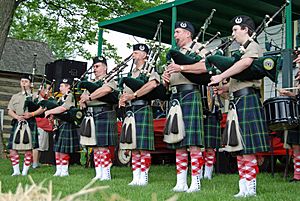Dress Act 1746 facts for kids
| Act of Parliament | |

|
|
| Long title | An act for the more effectual disarming the highlands in Scotland; and for the more effectual securing the peace of the said highlands; and for restraining the use of the highland dress; and for further indemnifying such persons as have acted in the defence of His Majesty's person and government, during the unnatural rebellion; and for indemnifying the judges and other officers of the court of judiciary in Scotland, for not performing the northern circuit in May, one thousand seven hundred and forty six; and for obliging the masters and teachers of private schools in Scotland, and chaplains, tutors and governors of children or youth, to take the oaths to his Majesty, his heirs and successors, and to register the same. |
|---|---|
| Citation | 19 Geo. 2. c. 39 |
| Dates | |
| Royal assent | 12 August 1746 |
| Other legislation | |
| Repealed by | Promissory Oaths Act 1871 |
|
Status: Repealed
|
|
The Dress Act 1746, also known as the Disclothing Act, was a law passed in Great Britain. It made it illegal for men and boys in the Scottish Highlands to wear traditional Highland Dress. This included items like the kilt, plaid, and tartan fabrics. The law came into effect on August 1, 1746.
This act was part of a larger set of laws called the Act of Proscription. These laws aimed to control the Scottish clans. The clans had strongly supported the Jacobite risings, which were rebellions against the British government. The Dress Act was repealed in 1782. By then, kilts and tartans were no longer common everyday clothes in the Highlands.
Contents
What the Dress Act Did
The Dress Act made it against the law to wear specific types of clothing. It stated that from August 1, 1747, no man or boy in Scotland could wear "Highland clothes." This included the plaid, the philabeg (or little kilt), and trowse (trousers). It also banned any part of the special Highland clothing.
The law also said that no tartan or multi-coloured plaid fabric could be used for great coats or upper coats. If someone broke this law for the first time, they could be sent to prison for six months. If they broke it a second time, they could be sent away to a British colony overseas for seven years as punishment.
Who Was Allowed to Wear Highland Dress?
There were a few exceptions to this strict law. Soldiers serving in the British army's Highland regiments were allowed to wear the kilt. Veterans who had served in the military could also wear it. Important landowners, known as the landed gentry, were also exempt from the entire Act of Proscription. This meant they could still wear Highland dress.
Why the Dress Act Was Created
The Dress Act was put in place after the Jacobite rising of 1745. This was the last major rebellion by supporters of the exiled Stuart royal family. Many Scottish clans had fought against the British government during this uprising. The government saw the Highland dress as a symbol of clan identity and rebellion.
By banning the traditional clothing, the government hoped to weaken the clan system. They wanted to reduce the unique culture of the Highlands. This was part of a larger effort to bring the Highlands under tighter government control.
When the Dress Act Was Ended
| Use of Highland Dress Act 1782 | |
|---|---|
| Act of Parliament | |

|
|
| Citation | 22 Geo. 3. c. 63 |
The Dress Act was officially repealed on July 1, 1782. This meant that wearing Highland dress was no longer illegal. A special announcement was made in both Gaelic and English.
The announcement told "all the Sons of the Gael" (meaning the Scottish Highlanders) that the King and Parliament had ended the act. It said that Highlanders could now wear their traditional clothes again. This included the Truis (trousers), the Little Kilt, the Coat, and the Striped Hose, as well as the Belted Plaid. They could wear these clothes without fear of the law or their enemies.
After the repeal, there was a renewed interest in Highland culture. Groups like the Highland Society of Edinburgh were formed. They worked to promote the use of traditional Highland dress. This led to a revival of kilts and tartans, which became important symbols of Scottish identity. A famous event celebrating this was the visit of King George IV to Scotland in 1822.
See also
- Highland Clearances
- Highland Potato Famine
- Scottish national identity
- Wars of Scottish Independence


